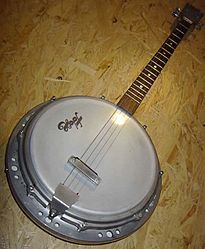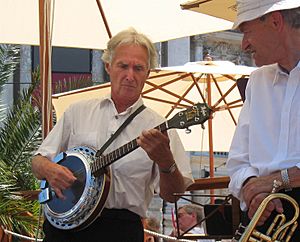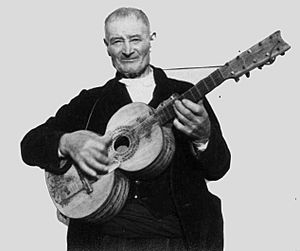Banjo facts for kids

A four-string banjo
|
|
| Classification | string |
|---|---|
The banjo is a string instrument with a thin skin stretched over a round frame, like a drum. It was first played by African slaves in the United States a few hundred years ago. The idea for the banjo came from other instruments in Africa.
The name banjo might have come from an African word, mbanza. It could also be from a word for the bamboo stick used for the banjo's neck.
Today, the banjo is often linked to country, folk, Irish traditional, and bluegrass music. Long ago, it was very important in African American traditional music. Later, it became popular in 19th-century minstrel shows. The banjo is also a key instrument in American old-time music and Traditional ("Trad") Jazz.
Contents
History of the Banjo
The modern banjo comes from instruments used in the Caribbean since the 1600s. These were played by enslaved people brought from West Africa. People started writing about the banjo in North America in the 1700s. It became easier to buy banjos from the early 1800s.
Many instruments in Africa, like the kora, have a skin head and a body made from a gourd or shell. Early African American banjos were different from these. Their necks did not have a Western-style fingerboard or tuning pegs. Instead, they had stick necks with strings tied on with loops for tuning. Banjos with fingerboards and tuning pegs were known in the Caribbean as early as the 1600s. Writers in the 1700s and early 1800s called these instruments by names like bangie, banza, bonjaw, banjer, and banjar.
In the southern United States before the Civil War, many black slaves played the banjo. They also taught their masters how to play it.
Playing Techniques
Two special ways of playing the five-string banjo are called rolls and drones. Rolls are fast patterns played with the right hand. They usually have eight notes in each musical section. Drone notes are quick, short notes. They are often played on the short fifth string to fill in around the main melody notes. Both of these techniques are very common for the banjo. Their sound is a big part of bluegrass music.

Five-string banjos are usually played with fingerpicks or just the fingers. But tenor banjos and plectrum banjos are played with a pick. This pick can be used to strum full chords. In Irish Traditional Music, it's often used to play single notes for melodies.
Modern Banjo Types
Today, banjos come in different types. The most common have four or five strings. There's also a six-string banjo that sounds and is played a lot like a guitar. Most banjo playing uses a fast, arpeggiated (broken chord) plucking style. However, there are many different ways to play.
The main part of a modern banjo is called the pot. It has a round rim, usually made of wood. A tight head, like a drum head, is stretched over it. In the past, this head was made from animal skin. Now, it's often made from plastic materials. Many modern banjos also have a metal "tone ring." This helps make the sound clearer and louder.
Banjos are usually tuned with special tuning pegs. These are different from the ones on guitars. Most banjos now have frets, which are metal strips on the neck. Frets help players hit the right notes. But some banjos don't have frets. These are used by players who want a sound like older banjos.
Modern banjos usually have metal strings. The fourth string is often wrapped with steel or a bronze-phosphor metal. Some players use nylon or gut strings for a softer, old-time sound.
Open-back and Resonator Banjos
Some banjos have a special plate on the back called a resonator. This plate helps send the sound forward and makes the banjo louder. Resonator banjos are often used in bluegrass music. They can also be used in old-time music when a player needs more volume.
Open-back banjos do not have this resonator. They usually have a softer sound and are lighter. They are often set up differently, with the strings a bit higher off the neck.
Five-string Banjo
The modern five-string banjo is based on an older design. The fifth string is usually thin, like the first string. But it starts higher up on the neck, at the fifth fret. This makes it shorter than the other strings. Because it's shorter, it can be tuned to a higher pitch. The five-string banjo uses a special tuning called reentrant tuning. This means the strings are not tuned from lowest to highest pitch in order. Instead, the fourth string is the lowest, then the third, second, first, and the fifth string is the highest.
Five-string banjo players use many different tunings. A very common one, especially in bluegrass, is called Open-G tuning (G4 D3 G3 B3 D4).
American old-time music often uses the five-string open-back banjo. It's played in different ways. The most common is called clawhammer or frailing. In this style, the player strikes the strings with a fingernail in a downward motion. Clawhammer players often use their thumb to hit the fifth string for a drone sound.
Bluegrass music almost always uses the five-string resonator banjo. It's played in styles like Scruggs style, named after Earl Scruggs. Another style is melodic, or Keith style, named for Bill Keith. There's also a three-finger style where single notes are played.
Banjo in Classical Music
The five-string banjo has been used in classical music for a long time. For example, Frederick Delius wrote for a banjo in his opera Koanga.
Four-string Banjos
Four-string banjos, like the plectrum and tenor types, can be used to play chords. They can also play single-note melodies, like in Irish traditional music. Players can also combine chords and melodies.
Plectrum Banjo
The plectrum banjo is a standard banjo but without the short fifth string. It usually has 22 frets on its neck. It's often tuned like the top four strings of a guitar. As its name suggests, it's usually played with a pick. This is different from the five-string banjo, which uses fingerpicks or bare fingers.
Tenor Banjo

The tenor banjo has a shorter neck, with 17 or 19 frets. It is also typically played with a pick. It became very popular after about 1910.
The tenor banjo was a common rhythm instrument in early 1900s dance bands. Its loud sound worked well with early jazz music. It could be heard clearly with other instruments like brass instruments and saxophones. In the 1920s, some Irish banjo players used tenor banjos to play the melodies of traditional Irish tunes.
The Low Banjos
In the late 1800s and early 1900s, it was popular to have groups of plucked-string instruments. These were like orchestras but with guitars, mandolins, or banjos. So, just like a symphony orchestra has violins, violas, cellos, and basses, banjo orchestras had different sizes of banjos.
Cello Banjo
The cello banjo is rarer than the tenor or plectrum banjo. It's tuned one octave lower than the tenor banjo, like a cello. It was used in banjo orchestras in the late 1800s and early 1900s.
Six-string Banjos
The six-string banjo was first made in Britain by William Temlet in the 1840s. He sold banjos with up to seven strings. Later, American player Alfred Davis Cammeyer created a five or six-string "zither" banjo around 1880. It had a wooden resonator and metal strings.
In the late 1890s, banjo maker F.C Wilkes made a six-string banjo. Its sixth string went through a "tunnel" in the neck.
Modern six-string bluegrass banjos have also been made. These add a bass string to a five-string banjo. Six-string banjos that have a guitar neck and a banjo body have become quite popular since the mid-1990s.
Banjo Hybrids
There are also instruments that mix the banjo with other stringed instruments. Most of these have the body of a banjo, but the neck of another instrument.
Images for kids
See also
 In Spanish: Banyo para niños
In Spanish: Banyo para niños












